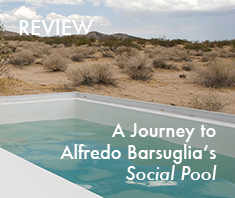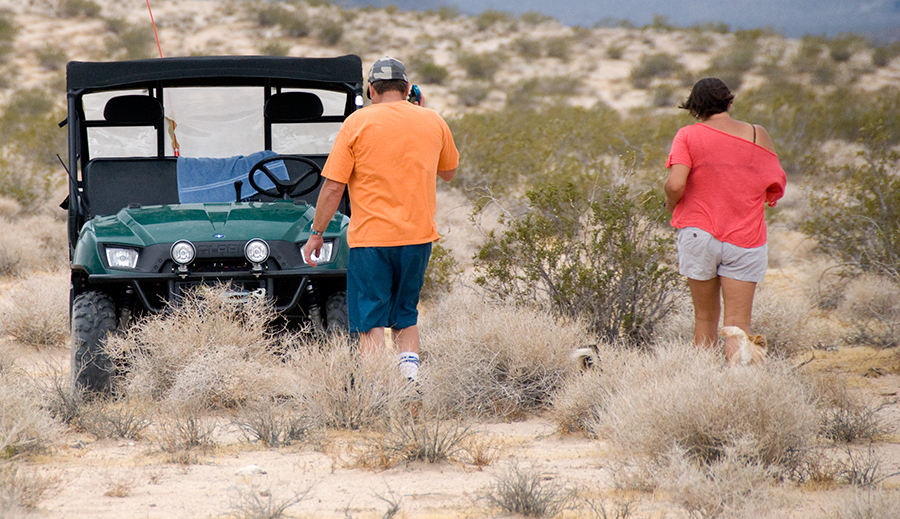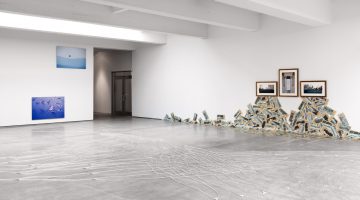“A Journey to Alfredo Barsuglia’s ‘Social Pool’”
By Chris Rusak
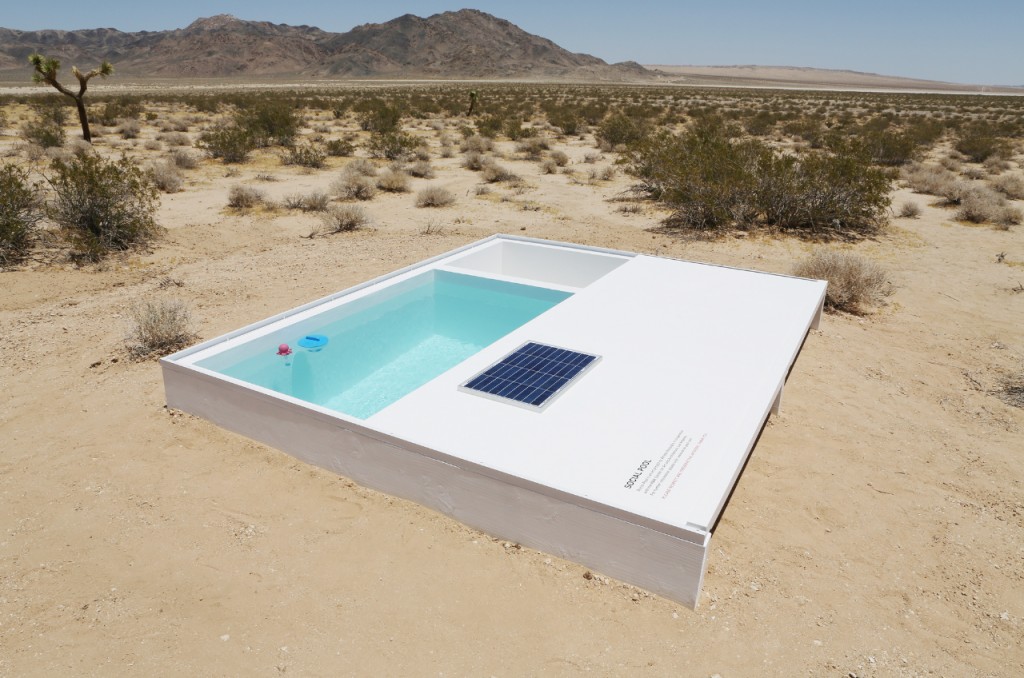
Alfredo Barsuglia, “Social Pool,” 2014. Courtesy the artist and MAK Center for Art and Architecture, Los Angeles.
In the middle of what many might call a barren wasteland, an outwardly nondescript open range of southeastern California desert, nevertheless home to many, from motorcyclists to meth-heads, artist Alfredo Barsuglia installed a small swimming pool. On July 5th, I went for a dip. His project is called “Social Pool” and is produced with the support of the MAK Center for Art and Architecture in West Hollywood. On its face, and as described in a MAK brochure that intimates umpteen possible readings of the work, “Social Pool” stands as a sculpture that requires a significant amount of resources—foremost time and transportation fuel—in order to partake in any of the experiences Barsuglia enables. This penetrable sculpture and the journey to it, the artist hopes, will provide participants time “to reflect on our consumption and entertainment-driven lifestyle,” while dunked in a spatially constrictive, water-filled structure surrounded, mostly, by silent nothingness. While these aims are not entirely off the mark, considering its actual location and the resulting viral press that has recently circulated, a journey to “Social Pool,” a dip in its waters, and, for us, a stroke of chance, actually reveals that “Pool” is a unique bullseye in the middle of highly coveted land. “Pool” may not be the only mirage in this oasis, which for a lover of the arid outdoors is the desert surrounding the white box, since access to the lively, surrounding sandy plain may too disappear for all shortly after the sculpture is scheduled to be disassembled.
My hallucinatory journey to “Social Pool” materialized in part due to “Los Angeles Times” reporter Carolina A. Miranda’s recent article, “Does the Mojave desert need an artist-built swimming pool? Maybe.” I immediately wanted to discover my own answer to her question. I had already, for several months, a trip out to the desert for the holiday weekend planned; a somewhat-annual ritual with a partner-in-crime flying in from New York. Miranda’s article popped up on my Twitter feed on June 27th, and after a few quick text messages my camping partner agreed we would be fools not to adjust course and add the swim to our route. The “hallucinatory” aspect of the trip, however, was not from a Thompson-esque narcotic thrust behind the wheel, but from the fact that on the day we chose to go to “Pool”, there was an earthquake in Big Bear City and multiple lightning-filled thunderstorms weeping heaves of rain across San Bernardino and Imperial Counties, all coloring our ride. The sun beamed, yet thick black clouds cancelled out patches of the sky, creating a surreal lightscape over the mountains, seen through the windshield, which acted as a cinematic frame around another of California’s wonderful stages of big wide open. Flash flood warnings were in effect throughout the day, which later nullified the ground of our evening’s campsite and forced us to change plans and retreat. Nature’s theatricality certainly heightened the overall experience of the journey. And as I sat behind the wheel stuck in a staccato of saying “wild” repeatedly after each of the jolted, numerous shifts of weather and land, I couldn’t help but think to myself, “Damn, everyone needs to do this,” as I pondered what to make of the theater Barsuglia constructed before embarking for “Social Pool.”
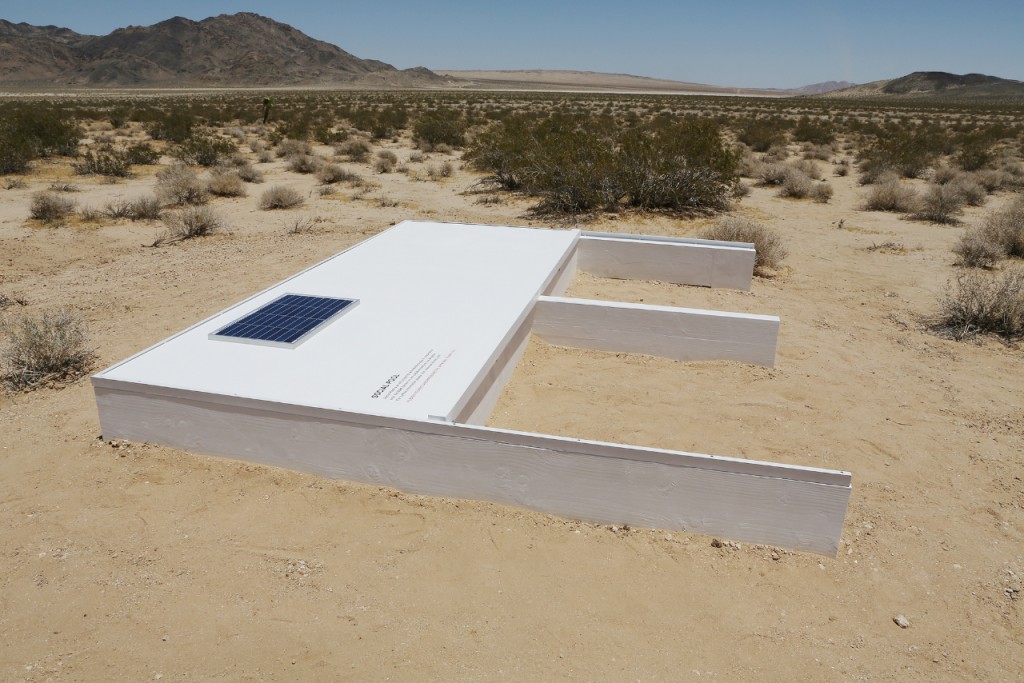
Alfredo Barsuglia, “Social Pool,” 2014. Courtesy the artist and MAK Center for Art and Architecture, Los Angeles.
In order to actually receive the opportunity to visit “Pool”, one must first leap through some artist-imposed hoops. Certainly less dangerous than a threatening desert flash flood, they are nonetheless a bit drenching. To start, one must journey to West Hollywood early in the morning in order to be the first person at MAK, who then gets the sole golden ticket up for grabs each day. This could be a potentially time-consuming, buzz-kill schlep for a hopeful participant within or far from Los Angeles proper. The successful early bird then naturally signs an agreement/liability waiver that reveals the GPS coordinates of a general location to which they must voyage. A key is turned over, vows of secrecy about the location are sealed, rules are outlined, copyrights asserted, and the publication of photographic images are prohibited by the artist; proscriptions on discussing the agreement, however, are not stipulated. Participants have 24 hours of pool pleasure and are expected to return the key the following day by 11 am. Though the pool may be deemed “Social” and Barsuglia expects you’ll bring some friends to make it such, these constraints feel anything but gregarious.
Now, briefed and readied for the freeways’ and nature’s battlefields, participants can expect about three hours of travel before reaching the white box. While the agreement does warn participants about desert conditions, and heeds demand to bring water not only for quenching thirst, but also for rehydrating the pool, hopeful swimmers should be warned about more than a few unmentioned hazards that lie ahead. The road to the pool destroyed the protective cover to my car’s undercarriage, and it is thus advisable to employ a high-profile vehicle with enough clearance for off-roading. The final road itself is in poor shape and timid or foolhardy drivers risk getting their vehicle stuck in its pockets of deep sand. Weakly inflated tires will certainly beckon a puncture from the rocky approach. Cell service is spotty at best—if you have any kind of emergency, car or otherwise, you’re screwed if not prepared.
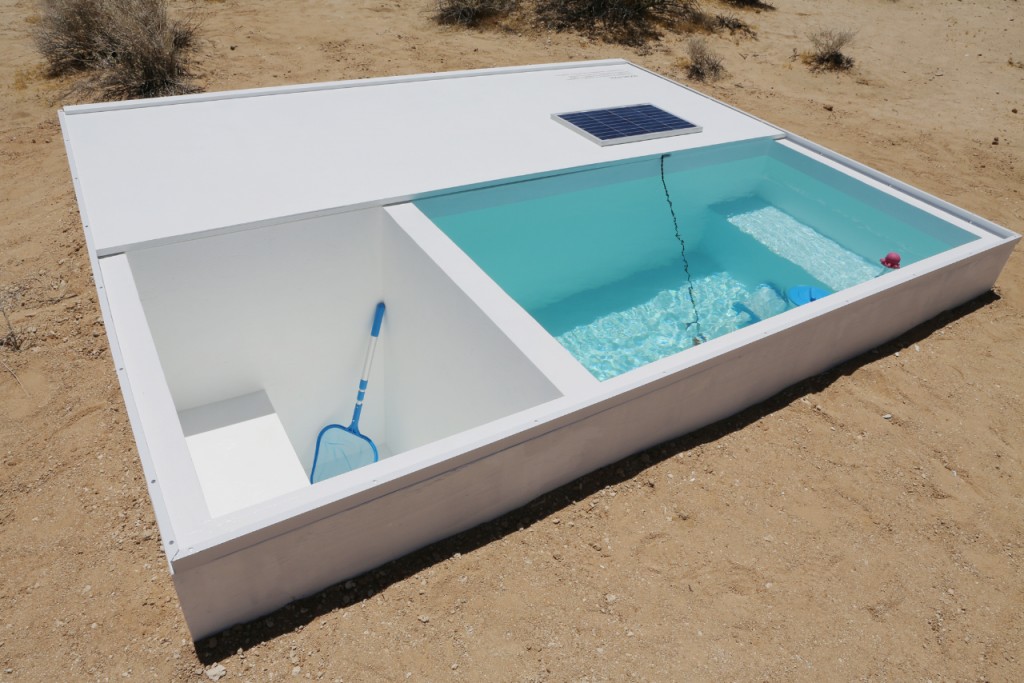
Alfredo Barsuglia, “Social Pool,” 2014. Courtesy the artist and MAK Center for Art and Architecture, Los Angeles.
But don’t let any of that scare you. The unsettling void of the surrounding nothingness will nibble at your mind the moment you realize how untethered you are from the urban jungle once you successfully leave the road and find “Pool”. If you can stop, stop and silence yourself, stop your thoughts and just look around, stop first at the edge of the road and realize how fast life is elsewhere, and you’ll begin to realize for how long you’ve already been swimming. And that was a little scary. Far scarier, though, may be the realization that you are suddenly being approached by people who you did not expect to be present in the middle of nowhere. This happened to us. You’ll ask yourself a lot of quick questions about what happens next, considering this experience was heretofore crafted to be somewhat exclusive just to us. Now the experience is really, suddenly social.
There’s nothing monumentally exciting about a white box filled with water that sits in the desert. It’s made of basic geometry, it’s certainly not an architectural marvel, and it’s nondescript, like the patch of map you’ll look at when you pop the coordinates into the internet to reveal its location. Scant landmarks lie within in a 50-mile radius. As Miranda notes, it’s “somewhere in the southern Mojave Desert between Joshua Tree and Apple Valley.” The closest non-natural feature on the map in those bounds is the 29 Palms Marine Corps Air Ground Combat Center, which is as sizable as the nearby Mojave National Preserve and Joshua Tree National Park. So, this small pool in the middle of nowhere, though the water was a comfortably warm 80º, is minuscule in size proportionate to its surroundings, and unremarkable as a container of water since only its absurd, yet absurdly beautiful location separates it from the experience of a warm bathtub at home. But, in the desert amongst the big, gorgeous wide open, the little features—the dots of creosote, chunks of serpentine, scurrying lizards and jackrabbits—truly stand out and catch one’s eye. That’s why two sudden, near dots in motion, one neon pink and the other neon orange, excited me like a clandestine rattlesnake hidden amongst the sagebrush ready to spook you.
The husband and wife and their two dogs that approached us were as excited to find the pool as we were to discover that they meant no harm. The pair live on an adjoining property and had heard about “Social Pool” from a flyer circulating throughout the local community. My silver car on the side of the road gave away the location of the hidden, locked treasure, but for my experience, so it goes, the treasure was them.
“We were worried the meth-heads came back,” she exclaimed, commenting on the intent of their reconnaissance and the local squatting phenomenon against which they must combat. In both supplemental information supplied by MAK and in recent emails with the artist, Barsuglia asserts that: “The location of the pool had to be in a very remote area, with no community nearby, no infrastructure, only nature.” But the artist fails to recognize (or acknowledge, perhaps to maintain an element of mystery) that, in fact, a rich community of interesting people surrounds the general area of his project. We all excitedly chatted for about 45 minutes as they discussed their residency in the area for the past eleven years. They pointed out their property and homes, squintingly visible on the horizon. We received an impromptu history of where we were, its vibrant, local fellowship of desert lovers fighting for the land’s preservation, and the camouflaged but present dangers of which we were unaware. “There are pit bulls, wild pit bulls the size of a table out there that will attack you,” he said, scaring the shit out of us. “And over there is a flat mine,” pointing toward an area as generally camouflaged as the one where “Pool” is located. “One step and you’re gone, it’s just an edge and one steep drop.” He then noticed the dogs had been gone for a while and remarked,, “I hope they didn’t fall in. We’d never get them out,” and yelled their names for several minutes until we finally saw them hop over a distant hill, running excitedly toward us.
It turns out the flat mine is about a mile away from the pool, so we were provided a little local’s theater customized for an outsider. But, at the time, in order to dissociate from the swirling thought of my unforeseen death as a result of a journey into art, I began to think of Marfa, Texas, where Donald Judd’s playground of minimalism, The Chinati Foundation, thrives, too, in the middle of nowhere. I began to think how other parcels of land in the area of “Pool“, like many already tucked in the vicinity and revealed to us by the couple, could become an ad hoc Marfa of its own. I began to calculate whether I could buy my own parcel and join this process. “Do a lot of people own this land, or…” I muttered. “It’s BLM (The Bureau of Land Management). But the military is about to take it over,” replied the wife quickly with impassioned force. Ironic, that, since Chinati is military land decommissioned in service to art. But, sadly, the couple then detailed a dispute between their community and outdoor enthusiasts against the government, underway over the past several years. The dispute was recently settled with a Congressional allowance for the Marine Corps to annex 79,000 acres of previously public, recreational land and timeshare a bulk of the rest, so as to expand their training capabilities while maintaining some public access. In my discussions with Barsuglia by email about his choice of parcel for the project, he mentions no awareness of the Marine Corps about to become his next-door neighbor, or that “Social Pool” was concerned with the impending loss of public land, a space he romanticizes as “remote and deserted. The view is amazing, the wideness of the land breathtaking.” Fundamentally, aesthetics motivated the artist’s choice of site for the art work.
Though the land around “Social Pool” is already dangerous, it is about to become, literally, a war zone where the military stages combat theater to prepare for another unknown future confrontation, presumably against terror. Barsuglia may hope for participants to ponder luxury goods, aesthetically gratifying landscape decorations, and meditative city escapes, but I haven’t given much thought to any of that. Myriad artists create work in the city that stimulates conversation about economic incongruities and the megalomaniacal ego-tripping on show each day—and many of the pool-owning celebrities cum artists cover that trope. Relinquishing more of the beautiful public desert to the military/industrial machine, much like many Middle Easterners have seen their desert landscapes scorched by warfare, affects me much more. In fact, the soon-to-expand 29 Palms is home to the Mojave Viper training program, where soldiers find a faux Iraqi village constructed for preparatory, fake fighting. Marfa, similarly, contains a faux Prada store created by artists Michael Elmgreen and Ingar Dragset, at which visitors can ponder the lengths travelled to score luxurious and treasured goods, or even just art itself. Now knowing what our surprise visitors revealed to us, conceptualizing this art work as a parsing of consumer luxuries and commoditized natural resources just appears as another screen that distracts viewers from the real action of a scene.
The brochure at MAK states that “’Social Pool’ is not a nostalgic affair.” I must disagree. Coming home, as a result of my visit I found myself longing for the days of my youth when I was ignorant of a militaristic presence continually creeping into more pockets of my daily life: at airport checkpoints, on subway platforms, and, now, in the middle of nowhere on land near where I regularly camp. Each successive war in American history chips away more of the very freedom we purport to promote and defend. Participants who might utilize a particular, circuitous route to “Social Pool” will pass through an INS Checkpoint where they will be questioned about their citizenship and have their car searched, not at the border, but 70 miles inside California. These sentries feel as ridiculous and wasteful as the purported need to expand simulated battlefields across ground once preserved, as Theodore Roosevelt believed, for an American’s right to enjoy their freedom in the wild. Again, according to the brochure: “’Social Pool’ was conceived of as an experience encompassing a potentially transformative journey, a promise of relaxation, the peace of remoteness, all while staying tuned in.” Tuned in, yes—but peace and relaxation only to those who remained tuned out. And if the pool were to remain 18 months into the future, then only with heavy earplugs.
Unlike the neighboring publicly open lands, though, Barsuglia tries to control access to this spot, much like the military hopes to do with their annex. In emails, the artist has expressed a desire to remain mum on the ownership of the pool’s parcel, so it remains unclear to visitors whether they are trespassing, on public land, or on a private property to which access has been granted for this event. I’m not entirely convinced withholding that information is of any real purpose to the project, beside keeping its location secret. Yet, type “social pool” into any search engine and the results are astounding; in a short period of time, everyone from Gizmodo to ABC News to the Smithsonian is talking about this work. Pictures and videos are being posted to social media networks, some of which help to reveal its secret location. It’s only a matter of time before EXIF location data on someone’s photo inadvertently gives away the coordinates to anyone who does a little digital forensic work, and frankly, it’s only a matter of time before the coordinates themselves go public. So, a pool plonked in the middle of a desert as advertised and controlled by Barsuglia really does recreate the stupidity of endless, unused private pools in fenced-off local places. Do we need to put that exact type of object in the place where many of us already aware of that stupidity retreat? I’m not convinced we do, if for selfish reasons alone.
Moreover, the fact that it takes a lot of gas to go for a dip flashes red. It’s just about a tank of gas for a round trip from MAK to pool and back; let’s call it twelve gallons. Factoring out Priuses, whose low profile would be eaten by the road, and assuming there are roughly 90 days of availability for participants to get the key, that’s nearly 1,100 gallons of gasoline expended for art that also nods to the water drought underway in California. According to the U.S. Energy Information Administration, that equals about 21,604 pounds of carbon dioxide released into the atmosphere, or about 10 tons. Barsuglia’s pool roughly measures 11 x 5 x 5 feet in size, or around 275 cubic feet (but technically less, given its interior design). A cubic foot of water weighs about 62.4 pounds, so the pool holds about 17,160 pounds of water. By the time of the pool’s intended closure, more pounds of carbon dioxide, now scientifically proven as a factor in the current drought, will have been produced as a result of visits to “Pool” than the weight of the water it holds. I dislike art work, as the MAK brochure suggests, that “share[s] a palpable and explicit idealism” with environmentally concerned Land Art and “understands itself as the product of an economy in which privacy and immateriality have been fully commodified,” by creating a private (yet “Social”??) experience by immaterializing its own impact of requiring participants to burn a significant amount of the very commodities to which the work aims to call attention. It chastises the absurd act by forcing participants to recreate it. If we are to consider this socially conscious art, a poor method has been employed for the force of its argument.
Because I already had a trip planned to the general area, my perspective of the work differs than that of a sudden day-tripper amused by the work’s prospects. My resource and time investment are a little less than the average participant. I like art work that exists in nature, especially if it intends to faithfully advocate for its preservation, and more so when site specificity plays a part. Successful accomplishment of this latter point strengthens aesthetic, conceptual, and political concerns equally. Had I taken this trip solely to visit “Pool” and if I didn’t have the chance encounter with locals, I believe my reaction would have been one of more disappointment regarding the work. This project, and the pool specifically, exist as a foreign object ignorant of the community to which it draws visitors. Going there for a private pool feels like segregating part of a party otherwise open to all. The Mojave Desert doesn’t need an artist-built pool—on the contrary, it needs a little more respect from its stewards and visitors to prevent further decay. Visitors to the Mojave National Preserve find immediately the results of governmental ignorance and eventually of hikers’ disrespect. Sending art lovers out into the middle of the desert to encourage pondering the sins of the cities’ halls of commerce and the selfishness of excess consumption and rampant privation is a selfish construct itself, one which prioritizes artistic control rather than public action. Barsuglia gives participants, apart from a chance to soak, no explicit option to do something in response to such privation, other than to get angry and complain about situations that prioritize luxury over rationality, or to tune out, give in, and enjoy the dip. I’ll choose the former, and since talk alone is cheap, instead of wasting a plastic gallon of water to pour into a mirage, I’ll bring an extra trash bag on my next hike in order to stuff it with a trail’s litter selfishly discarded by someone else. (And the land around the pool could use some such tending.) Will you, too?
Chris Rusak is an artist who lives in Los Angeles and frequently sleeps beneath the Mojave sky.
Previous contributions by Chris Rusak include:
Hitchhiking: Joshua Podoll at Christopher Grimes Gallery, Santa Monica
